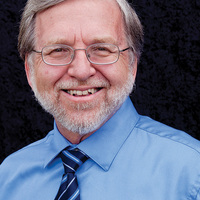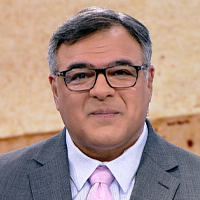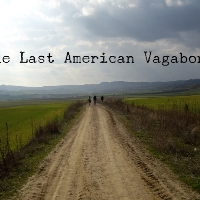Why Should I Be Baptized? by William Dupley
Five people were baptized in our church a few Sundays ago, including a small girl. I spoke to her father this week, and he said my daughter told me that all of her fear was gone since she was baptized.This week, I was discussing Baptism with a friend of mine. He had ministered in Haiti, and he said it was very common for people to experience deliverance when they were baptized. Deliverance also occurred when people were baptized at a camp meeting that Toronto Airport Vineyard conducted at Staynor camp in 1992.
I remember praying for a lady once at church, and when I laid my hands on her, she fell down to the floor in the form of an idol and went into a trance. I wasn't quite sure what happened, but I figured there had been some power encounter between the Holy Spirit and some spiritual force. I asked her friend who was with this woman if she was a Christian, and she said yes, she was. I asked her if she had been baptized. She said yes. I then spoke to the spiritual force and told it that you have no right to be on this woman because she had identified herself with Christ through the waters of Baptism, and you belong to the old man. I command you to leave and go to the tank, where the Baptism occurred. Immediately, she was delivered and came out of the trance.
Why does this not always happen
I've seen many people baptized, and I rarely see people experience deliverance when they are baptized. I suggest this is because they are not taught what really happens when someone is baptized. Often, Baptism is taught as a symbolic activity. I have heard it said it is the outward sign of an inward commitment, sort of like joining the union and getting the union badge that you put on your coat. Nothing could be farther from the truth. In fact, these statements rob the true power of what Baptism accomplishes in our lives.
Types of Baptism
The Greek word for Baptism is baptízō – properly, "submerge" (Souter); hence, baptize, to immerse (literally, "dip under"). It does not always mean water baptism. It means to be immersed in something.
There are three different types of Baptism mentioned in the New Testament. Each has a different purpose.
1. Baptism into Christ
When we accept Christ as our Saviour and Lord, three things happen
1. We are baptized into Christ. We are immersed in God.
Gal 3:26 You are all sons of God through faith in Christ Jesus. 27 For all of you who were baptized into Christ have clothed yourselves with Christ
2. Our Spirit becomes one with God's Spirit.
1 Corinthians 6:17 But whoever is united with the Lord is one with him in Spirit.
3. We become a new creation.
2 Cor 5:17 17 Therefore, if anyone is in Christ, he is a new creation. The old has passed away. Behold, the new has come!
Jesus commands us to baptize people in Matthew 28:19 20 as part of the process of disciplining people.
Therefore go and make disciples of all nations, baptizing them in the name of the Father, and of the Son, and of the Holy Spirit, 20 and teaching them to obey all that I have commanded you. And surely I am with you always, even to the end of the age."
I don't think Jesus is saying that we just water baptize people in the name of the Father, Son, and Holy Spirit in this verse. Rather, I think Jesus is saying that we immerse people in the (love of the) Father, (the grace of) Jesus, and (the fellowship of) the Holy Spirit since he is talking about making disciples in this verse. A key part of making disciples is helping them develop an intimate relationship with God.
2. Baptized in the Holy Spirit
When we accept Christ, our Spirit is united with Holy Spirit, but there is an additional experience that Jesus prophesied would happen to us in Acts 1:4-5
4 And while they were gathered together, He commanded them: "Do not leave Jerusalem, but wait for the gift the Father promised, which you have heard Me discuss. 5 For John baptized with water, but in a few days you will be baptized with the Holy Spirit."
This prophecy was fulfilled in Acts 2: 4
4 And they were all filled with the Holy Spirit and began to speak in other tongues as the Spirit enabled them.
When we are baptized with Holy Spirit. Our entire body is immersed in the Holy Spirit, and His presence overwhelms us. We feel his presence penetrate our physical being. Just as water soaks us when we are immersed in water, so Holy Spirit soaks our physical being. We also begin to manifest the gifts of Holy Spirit as outlined in I Cor 12
3. Baptism in water
The Book of Acts describes many events where people believed and were immediately baptized. They were immersed in water. In fact, it seemed that in most cases, a person was baptized immediately upon repentance and acceptance of Christ. There is one particularly fascinating example. There was an Ethiopian eunuch who was responsible for the entire treasury of Ethiopia. He had come to Jerusalem to worship and was going back to Ethiopia. An angel directed Philip to catch up with his caravan, and he heard him reading the book of Isaiah. Philip asked him if he understood what he was reading. He said how can I unless someone guides me. They had a further discussion, and Philip began to tell him the good news about Jesus.
The Ethiopian made the most remarkable request after hearing what Philip had to say.
Acts 8:36 Now, as they went down the road, they came to some water. And the eunuch said, "See, here is water. What hinders me from being baptized?"
38 So he commanded the chariot to stand still. And both Philip and the eunuch went down into the water, and he baptized him.
Now, I want you to capture what happened here. This was a very wealthy man, and he would have had an entourage. He would have been dressed in very expensive clothes, yet it was so important for him to be baptized that he was prepared to get out of his chariot, go down to a muddy hole filled with water, and be baptized. I suggest there was something very compelling that Philip told him about the benefit of being baptized.
Jesus was Baptized in Water
Jesus felt it was so important to be baptized in water that he was baptized in water himself.
Matt 3: 13 At that time Jesus came from Galilee to the Jordan to be baptized by John. 14 But John tried to prevent Him, saying, "I need to be baptized by You, and do You come to me?" 15 "Let it be so now," Jesus replied. "It is fitting for us to fulfill all righteousness in this way." Then John permitted Him. 16 As soon as Jesus was baptized, He went up out of the water. Suddenly the heavens were opened and He saw the Spirit of God descending like a dove and resting on Him.
Jesus never sinned, yet He felt it was important to do this, and the question has to be asked: why did He do this? Jesus said, "It is fitting for us to fulfill all righteousness." I suggest He did this to demonstrate what has to be in our hearts when we are baptized. He humbled himself and publicly declared that His entire life was committed to God and that He was completely dedicating His life to living according to God's will and commands.
A leader leads by example. I think Jesus did this to be an example to all of us.
What happens when you are baptized in water
I do not believe that Baptism is just some symbolic or ritualistic activity. Jesus had no use for those things. I do not wish to minimize the symbolic aspect of Baptism. Baptism is a powerful and symbolic visual aid, a prophetic act demonstrating outwardly what the Lord has done and is doing inwardly. It speaks loudly to the fact that this person needs a bath to be cleansed and needs a burial of the old man to rise up in the newness of life in Christ. But to say it is just symbolic negates the spiritual transformative aspect of Baptism.
Romans chapter 6 :3-7 describes Baptism in great detail and what really happens when we are baptized.
3 Or don't you know that all of us who were baptized into Christ Jesus were baptized into his death? 4 We were therefore buried with him through Baptism into death in order that, just as Christ was raised from the dead through the glory of the Father, we too may live a new life.
5 For if we have been united with him in a death like his, we will certainly also be united with him in a resurrection like his. 6 For we know that our old self was crucified with him so that the body ruled by sin might be done away with, a that we should no longer be slaves to sin— 7 because anyone who has died has been set free from sin
Let's start by looking at what happens when we are baptized:
1. We are baptized into Christ Jesus.
2. We were baptized into his death.
3. We were buried with him.
Now let's look at the results, what we can expect as a result of being baptized
1. We may walk in the newness of life (The newness of life is the life that God intended for us to live)
2. We will be resurrected.
3. Our old self was crucified with him so that the body ruled by sin might be done away with (rendered powerless)
4. We will no longer be slaves to sin
Let's look at some other results of being baptized
1. He will forgive your sins. Acts 2:38
2. You will receive the gift of the Holy Spirit Acts 2:38
3. He will wash away your sins. Acts 22:16
4. Whoever believes in him and is baptized will be saved, but whoever does not believe will be condemned. Mark 16:16. This Scripture is not saying that you have to be baptized to receive salvation. Salvation is by grace. Whether we are baptized or not, we will be saved if we believe in the Lord Jesus Christ. However, the word for "saved" used here is the Greek word "sozo". The word "sozo" means "safely rescued, delivered out of danger in to safely used principally of God rescuing believers from the penalty and power of sin into his provisions of safety." It is clear from this verse that a real spiritual transaction occurs when we are baptized that delivers us from the results of our sins.
5. You are baptized into the body of Christ (the family of God) (1 Cor. 12:13). In other words, it is also an initiation into the fraternity of Jesus.
These actions and results don't sound very symbolic to me. It clearly sounds like a dramatic spiritual transaction occurs.
Who is buried, who is crucified?
Romans 6:6 states
"Knowing this, that our old self was crucified with Him, in order that our body of sin might be done away
The King James bible reads
6 Knowing this, that our old man was crucified with Him, that the body of sin might be done away with, that we should no longer be slaves of sin.
We read here that it is our old self or old man that is buried. Now, you may wonder who this is. I suggest that your old self or old man is the spiritual being you were before you were born again and became a new creation. Our old man has committed a lot of sins and has also inherited a lot of curses from the generations that have gone before.
When we are baptized, the old man is buried. We choose to bury him. He's put to death. It's an execution, and anything related to the old man goes with it.
Sins give rights to demonic forces. The spiritual world is very legalistic. Negative Spiritual forces cannot attack us or touch us unless we give them legal rights to do that. Prov 26:2 clearly states this.
Like a flitting sparrow, like a flying swallow, So a curse without cause shall not alight.
However, when we do sin, or our parents sin, it gives rights for a curse to come upon us. When we are baptized, we put to death the old man and the rights that are associated with the old man are made null and void. The spiritual forces that are associated with those rights must leave. They have no legal right to be there. That is why Baptism is so important. This is how Baptism saves us. The act of Baptism rescues and delivers us out of danger. It delivers us from the penalty and power of sin into Our Heavenly Father's provisions of safety".
Deliverance is the children's bread.
I have experienced three seasons of deliverance emphasis in the church. There was a great emphasis on deliverance in the late 1970s, it came around again in the 1990s, and it's starting again in the 2020s. The challenge with deliverance is that people often become consumed with looking for demons. Only one-third of Jesus's ministry was focused on deliverance. If you are spending more than one-third of your ministry time on deliverance, I suggest you readjust your focus. However, ignoring deliverance is also a mistake.
Jesus called deliverance the children's bread in Matthew 15. A Canaanite woman had asked him to deliver her demon-possessed daughter. His response was unusual. He said
24 He answered, "I was sent only to the lost sheep of the house of Israel." 25 The woman came and knelt before Him. "Lord, help me!" she said. 26 But Jesus replied, "It is not right to take the children's bread and toss it to the dogs." 27 "Yes, Lord," she said, "even the dogs eat the crumbs that fall from their master's table." 28 "O woman," Jesus answered, "your faith is great! Let it be done for you as you desire." And her daughter was healed from that very hour.
Jesus called deliverance the children's bread. We are the children of God, and deliverance is our bread, too. It's something that we can expect.
First John 3:1
See what great love the Father has lavished on us, that we should be called children of God! And that is what we are!
How do you acquire the results of Baptism?
The first step in Baptism is repentance.
Acts 2:38 Peter replied, "Repent and be baptized, every one of you, in the name of Jesus Christ for the forgiveness of your sins. And you will receive the gift of the Holy Spirit.
Repent means "to change one's mind or purpose". When we repent, we choose to change how we think, what we do, and how we behave, from the way the world thinks to the way God thinks. We start by asking God's forgiveness for our sins. I recommend that this be done thoroughly and not just as a general statement. We commit sins individually. We should ask forgiveness and repent the same way. Remember, our sins provide the spiritual world with legal rights over us, so the more thorough we are with our repentance, the more legal rights are broken. Now, I don't believe you need to repent of every sin you did. I don't think we can remember them all, but I think we can repent for sins in categories.
The Sozo ministry has a good structure for examining ourselves and structuring our repentance. There are four categories they would suggest that you consider when deciding to get serious in the area of repentance. These categories are Sexual sin, Occult, Hatred, and fear. I recommend that you take the time to do this well and not be in a hurry. I also suggest you ask God's forgiveness for generational sins as well. Often, the sins of our ancestors can affect us because they have given rights to the spiritual world to affect their descendants.
The second step is a public declaration.
When we are baptized, we publicly declare our allegiance to Jesus Christ, identify ourselves with the cross of Christ, and are baptized into Christ. We acknowledge that our old man is about to be crucified and buried in the tank, and because we have repented of his sins, the spiritual forces related to the old man must stay in the tank and have no right to be on you.
Now, if you did not understand this when you were baptized and thought that you were just making an outward sign of an inward commitment, you can correct that situation today. There are no time issues with our Heavenly Father. He lives outside of time. I suggest that you can make that declaration today, even though you may have been baptized 50 years ago.
If you would like to acquire all the benefits of your Baptism, I encourage you to do this prayer with me.
The Prayer
Heavenly Father, I now understand that being baptized is much more than just making an outward sign of an inward commitment, and I want to acquire all the benefits that Jesus purchased for me on the cross.
1. I ask forgiveness for my sins and the sins of my ancestors. (Be specific, and don't be in a hurry.) I repent for doing these things, and as an act of my will, I change my mind and choose to live according to your will and commandments. I ask you for your help to do this.
2. I believe that Jesus Christ died on the cross, rose from the dead on the third day, and is sitting with his Heavenly Father today.
3. I received his gift of forgiveness that was paid by the atonement he made for my sins on the cross.
4. I declare that Jesus Christ is my Savior and Lord.
5. I choose to follow him in the waters of Baptism and identify with His cross by the act of Baptism, and by doing so, I choose to bury my old man and everything that is associated with him. These include all my sins, all my ancestors' sins, and all curses that were related to those sins.
6. I rebuke every spiritual force that's associated with my sins and my ancestors' sins.
7. In Jesus' name, I command these spiritual forces to go to the baptismal tank and never bother me again because you have no rights on me.
Congratulations, you have now dealt with any spiritual forces related to your old man, and you have the authority to tell any temptation that would try to drag you back into those sins to leave you because you have repented, are baptized in Christ, and they have no rights on you.
You will now find it easier to walk in the newness of life. Jesus is committed to helping you be transformed. This process is called sanctification. You have put off the old man, and your mind will be renewed.
Eph 4:22 that you put off, concerning your former conduct, the old man which grows corrupt according to the deceitful lusts, 23 and be renewed in the spirit of your mind, 24 and that you put on the new man which was created according to God, in true righteousness and holiness.
It does take your whole life to become what you are in Christ, but choosing to be baptized is the best way to start the journey.
I bless you all. I hope this has been helpful. Please write to me if you experience a change in your life as a result of this prayer. I would love to know about it.
This blog is originally published here:https://thesecretplace.ca/blogs/f/why-should-i-be-baptized
People
Circles
Posts
Live Reports From Anti-Israel Protests At UT And From Around The Nations On College Campuses https://madmaxworld.tv/watch?id=66310fefae5a024863595b9f
The U.S. federal government has gone ROGUE and now only seeks to HARM people and DESTROY nations
https://www.brighteon.com/00d63a04-b179-4585-bd86-32122f59c768

- US government's focus on causing harm to people and nations. (0:03)- US Empire's terrorism and economic collapse. (4:37)- Preparedness items, including food, supplements, emergency comms devices, and firearms. (11:45)- Preparedness solutions for chaos and collapse. (15:28)For more updates, visit: http://www.brighteon.com/channel/hrreport NaturalNews videos would not be possible without you, as always we remain passionately dedicated to our mission of educating people all over the world on the subject of natural healing remedies and personal liberty (food freedom, medical freedom, the freedom of speech, etc.). Together, we’re helping create a better world, with more honest food labeling, reduced chemical contamination, the avoidance of toxic heavy metals and vastly increased scientific transparency.▶️ Every dollar you spend at the Health Ranger Store goes toward helping us achieve important science and content goals for humanity: https://www.healthrangerstore.com/ ▶️ Sign Up For Our Newsletter: https://www.naturalnews.com/Readerregistration.html ▶️ Brighteon: https://www.brighteon.com/channels/hrreport ▶️ Join Our Social Network: https://brighteon.social/@HealthRanger ▶️ Check In Stock Products at: https://PrepWithMike.com 🔴 Brighteon.Social: https://brighteon.social/@HealthRanger 🔴 Gettr: https://gettr.com/user/naturalnews 🔴 Gab: https://gab.com/NaturalNews 🔴 Bitchute: https://www.bitchute.com/channel/naturalnews 🔴 Rumble: https://rumble.com/c/HealthRangerReport 🔴 Mewe: https://mewe.com/p/naturalnews 🔴 Spreely: https://social.spreely.com/NaturalNews 🔴 Telegram: https://t.me/naturalnewsofficial 🔴 Pinterest: https://www.pinterest.com/realhealthrangerstore/
www.brighteon.com
Videos
On this episode of the Whistleblowers, John Kiriakou discusses the Julian Assange trial verdict with Mohammed Elmaazi, an investigative journalist and editor-in-chief of The Interregnum.
Culdesac is a new neighborhood development in Tempe, Arizona designed around "car free" living. Praised for being environmentally friendly and its walking distance convenience, is this essentially the nations first "15 minute city?"
Welcome to The Daily Wrap Up, a concise show dedicated to bringing you the most relevant independent news, as we see it, from the last 24 hours.
All Video Source Links Can Be Found Here At The Last American Vagabond: https://www.thelastamericanvagabond.com/cia-zionists-sacrifice-jews-agenda
Want to send a check to support TLAV, or just words of encouragement?
Use our new P.O. box:
Ryan Cristian
1113 Murfreesboro Rd. Ste 106-146
Franklin, Tn 37064
Get TLAV Apparel:
https://truthclothing.io/collections/tlav
https://tlavfreespeech.itemorder.com/shop/home/
Support TLAV through Autonomy:
Join Autonomy:
https://www.universityofreason.com/a/29887/QZmKjVCA
Ryan Cristián’s Objectivity Course:
https://marketplace.autonomyagora.com/objective-research
Richard Grove’s Course:
https://www.universityofreason.com/a/2147526145/QZmKjVCA
Like What You See? Help Us Stay People Funded:
https://www.thelastamericanvagabond.com/donations/donation-form/
https://www.paychute.com/c/b7c68a5b-d437-444c-973b-e0413a5e07c3
https://www.subscribestar.com/the-last-american-vagabond
https://cash.app/$TLAVagabond
https://www.buymeacoffee.com/tlavagabond
https://tlavagabond.substack.com/
Bitcoin Donations: 3HybuDuvH4x5uJHemgc7EW4ms2nz3F8Gah
Ethereum Donations: 0x5e68B8984d9D8167dAf890588a7037Ae6Cc87d4b
Litecoin Donations: MX3T2kYvzfD4mNS4VNSyXFgY4abhUJC5ff
Bitcoin Cash Donations: qqsef23980qu5nlk2dj7s7ezwedl4fmy2gl2mxp9dp
Support The Last American Vagabond by Subscribing here:
http://www.feedblitz.com/f/?Sub=906867
The Last American Vagabond Links:
Sovern: https://sovren.media/u/tlavagabond/
Rumble: https://rumble.com/user/TheLastAmericanVagabond
Odysee: https://odysee.com/@TLAVagabond:5
Rokfin: https://www.rokfin.com/TLAVagabond
Minds: https://www.minds.com/TLAVagabond
Bitchute: https://www.bitchute.com/channel/24yVcta8zEjY/
Telegram: https://t.me/TLAVagabond
VK: https://vk.com/id504366611
Twitter: https://twitter.com/TLAVagabond
Instagram: https://www.instagram.com/the_last_american_vagabond/
TikTok: https://www.tiktok.com/@thelastamericanvagabond
Getter: https://gettr.com/user/tlavagabond
TruthSocial: https://truthsocial.com/@TLAVagabond
Locals: https://thelastamericanvagabond.locals.com/
Facebook: https://www.facebook.com/Vagabond-Censored-103475109010293/
Memo: https://memo.cash/profile/1Np4Z2d25RSsQi99gKhf2cd5CAwN57jk13
MeWe: https://mewe.com/profile/5bcfb5d2a5f4e5420d7d5a2f
BlueSky: https://bsky.app/profile/tlavagabond.bsky.social
#TLAVPirateStreams #TheDailyWrapUp #TheLastAmericanVagabond
"Copyright Disclaimer Under Section 107 of the Copyright Act 1976, allowance is made for "fair use" for purposes such as criticism, comment, news reporting, teaching, scholarship, and research. Fair use is a use permitted by copyright statute that might otherwise be infringing. Non-profit, educational or personal use tips the balance in favor of fair use.”
People
Circles
Videos
On this episode of the Whistleblowers, John Kiriakou discusses the Julian Assange trial verdict with Mohammed Elmaazi, an investigative journalist and editor-in-chief of The Interregnum.
Culdesac is a new neighborhood development in Tempe, Arizona designed around "car free" living. Praised for being environmentally friendly and its walking distance convenience, is this essentially the nations first "15 minute city?"
Welcome to The Daily Wrap Up, a concise show dedicated to bringing you the most relevant independent news, as we see it, from the last 24 hours.
All Video Source Links Can Be Found Here At The Last American Vagabond: https://www.thelastamericanvagabond.com/cia-zionists-sacrifice-jews-agenda
Want to send a check to support TLAV, or just words of encouragement?
Use our new P.O. box:
Ryan Cristian
1113 Murfreesboro Rd. Ste 106-146
Franklin, Tn 37064
Get TLAV Apparel:
https://truthclothing.io/collections/tlav
https://tlavfreespeech.itemorder.com/shop/home/
Support TLAV through Autonomy:
Join Autonomy:
https://www.universityofreason.com/a/29887/QZmKjVCA
Ryan Cristián’s Objectivity Course:
https://marketplace.autonomyagora.com/objective-research
Richard Grove’s Course:
https://www.universityofreason.com/a/2147526145/QZmKjVCA
Like What You See? Help Us Stay People Funded:
https://www.thelastamericanvagabond.com/donations/donation-form/
https://www.paychute.com/c/b7c68a5b-d437-444c-973b-e0413a5e07c3
https://www.subscribestar.com/the-last-american-vagabond
https://cash.app/$TLAVagabond
https://www.buymeacoffee.com/tlavagabond
https://tlavagabond.substack.com/
Bitcoin Donations: 3HybuDuvH4x5uJHemgc7EW4ms2nz3F8Gah
Ethereum Donations: 0x5e68B8984d9D8167dAf890588a7037Ae6Cc87d4b
Litecoin Donations: MX3T2kYvzfD4mNS4VNSyXFgY4abhUJC5ff
Bitcoin Cash Donations: qqsef23980qu5nlk2dj7s7ezwedl4fmy2gl2mxp9dp
Support The Last American Vagabond by Subscribing here:
http://www.feedblitz.com/f/?Sub=906867
The Last American Vagabond Links:
Sovern: https://sovren.media/u/tlavagabond/
Rumble: https://rumble.com/user/TheLastAmericanVagabond
Odysee: https://odysee.com/@TLAVagabond:5
Rokfin: https://www.rokfin.com/TLAVagabond
Minds: https://www.minds.com/TLAVagabond
Bitchute: https://www.bitchute.com/channel/24yVcta8zEjY/
Telegram: https://t.me/TLAVagabond
VK: https://vk.com/id504366611
Twitter: https://twitter.com/TLAVagabond
Instagram: https://www.instagram.com/the_last_american_vagabond/
TikTok: https://www.tiktok.com/@thelastamericanvagabond
Getter: https://gettr.com/user/tlavagabond
TruthSocial: https://truthsocial.com/@TLAVagabond
Locals: https://thelastamericanvagabond.locals.com/
Facebook: https://www.facebook.com/Vagabond-Censored-103475109010293/
Memo: https://memo.cash/profile/1Np4Z2d25RSsQi99gKhf2cd5CAwN57jk13
MeWe: https://mewe.com/profile/5bcfb5d2a5f4e5420d7d5a2f
BlueSky: https://bsky.app/profile/tlavagabond.bsky.social
#TLAVPirateStreams #TheDailyWrapUp #TheLastAmericanVagabond
"Copyright Disclaimer Under Section 107 of the Copyright Act 1976, allowance is made for "fair use" for purposes such as criticism, comment, news reporting, teaching, scholarship, and research. Fair use is a use permitted by copyright statute that might otherwise be infringing. Non-profit, educational or personal use tips the balance in favor of fair use.”
On this episode of the Cost of Everything we take a closer look at the cost of waste management. Host Christy Ai explains which countries are the biggest trash producers and which are the nations with a seemingly unlimited supply of foreign trash flowing into their dumps. Professor Lily Pollans joins the show to discuss how we can manage and dispose of the tons and tons of municipal solid waste and what kind of trash is really feeding the Great Pacific Garbage Patch and filling the landfills of Asian countries.
With today’s technology, you can achieve the Instagram face or body you have always wished for; but at what price? On this episode of The Cost of Everything, we take a look at how much bang for their buck patients are getting by traveling across the globe for cosmetic surgery. Host Christy Ai speaks with facial plastic surgeon Dr. William Lindsey about the pros and cons of medical tourism. Do patients want to come to the US and Western nations and pay more for higher quality surgeries? Or are people from the West going to traditionally poorer countries to receive services? And which nations are up and coming in terms of the quality and safety of the procedures they offer?
Posts
Why Should I Be Baptized? by William Dupley
Five people were baptized in our church a few Sundays ago, including a small girl. I spoke to her father this week, and he said my daughter told me that all of her fear was gone since she was baptized.This week, I was discussing Baptism with a friend of mine. He had ministered in Haiti, and he said it was very common for people to experience deliverance when they were baptized. Deliverance also occurred when people were baptized at a camp meeting that Toronto Airport Vineyard conducted at Staynor camp in 1992.
I remember praying for a lady once at church, and when I laid my hands on her, she fell down to the floor in the form of an idol and went into a trance. I wasn't quite sure what happened, but I figured there had been some power encounter between the Holy Spirit and some spiritual force. I asked her friend who was with this woman if she was a Christian, and she said yes, she was. I asked her if she had been baptized. She said yes. I then spoke to the spiritual force and told it that you have no right to be on this woman because she had identified herself with Christ through the waters of Baptism, and you belong to the old man. I command you to leave and go to the tank, where the Baptism occurred. Immediately, she was delivered and came out of the trance.
Why does this not always happen
I've seen many people baptized, and I rarely see people experience deliverance when they are baptized. I suggest this is because they are not taught what really happens when someone is baptized. Often, Baptism is taught as a symbolic activity. I have heard it said it is the outward sign of an inward commitment, sort of like joining the union and getting the union badge that you put on your coat. Nothing could be farther from the truth. In fact, these statements rob the true power of what Baptism accomplishes in our lives.
Types of Baptism
The Greek word for Baptism is baptízō – properly, "submerge" (Souter); hence, baptize, to immerse (literally, "dip under"). It does not always mean water baptism. It means to be immersed in something.
There are three different types of Baptism mentioned in the New Testament. Each has a different purpose.
1. Baptism into Christ
When we accept Christ as our Saviour and Lord, three things happen
1. We are baptized into Christ. We are immersed in God.
Gal 3:26 You are all sons of God through faith in Christ Jesus. 27 For all of you who were baptized into Christ have clothed yourselves with Christ
2. Our Spirit becomes one with God's Spirit.
1 Corinthians 6:17 But whoever is united with the Lord is one with him in Spirit.
3. We become a new creation.
2 Cor 5:17 17 Therefore, if anyone is in Christ, he is a new creation. The old has passed away. Behold, the new has come!
Jesus commands us to baptize people in Matthew 28:19 20 as part of the process of disciplining people.
Therefore go and make disciples of all nations, baptizing them in the name of the Father, and of the Son, and of the Holy Spirit, 20 and teaching them to obey all that I have commanded you. And surely I am with you always, even to the end of the age."
I don't think Jesus is saying that we just water baptize people in the name of the Father, Son, and Holy Spirit in this verse. Rather, I think Jesus is saying that we immerse people in the (love of the) Father, (the grace of) Jesus, and (the fellowship of) the Holy Spirit since he is talking about making disciples in this verse. A key part of making disciples is helping them develop an intimate relationship with God.
2. Baptized in the Holy Spirit
When we accept Christ, our Spirit is united with Holy Spirit, but there is an additional experience that Jesus prophesied would happen to us in Acts 1:4-5
4 And while they were gathered together, He commanded them: "Do not leave Jerusalem, but wait for the gift the Father promised, which you have heard Me discuss. 5 For John baptized with water, but in a few days you will be baptized with the Holy Spirit."
This prophecy was fulfilled in Acts 2: 4
4 And they were all filled with the Holy Spirit and began to speak in other tongues as the Spirit enabled them.
When we are baptized with Holy Spirit. Our entire body is immersed in the Holy Spirit, and His presence overwhelms us. We feel his presence penetrate our physical being. Just as water soaks us when we are immersed in water, so Holy Spirit soaks our physical being. We also begin to manifest the gifts of Holy Spirit as outlined in I Cor 12
3. Baptism in water
The Book of Acts describes many events where people believed and were immediately baptized. They were immersed in water. In fact, it seemed that in most cases, a person was baptized immediately upon repentance and acceptance of Christ. There is one particularly fascinating example. There was an Ethiopian eunuch who was responsible for the entire treasury of Ethiopia. He had come to Jerusalem to worship and was going back to Ethiopia. An angel directed Philip to catch up with his caravan, and he heard him reading the book of Isaiah. Philip asked him if he understood what he was reading. He said how can I unless someone guides me. They had a further discussion, and Philip began to tell him the good news about Jesus.
The Ethiopian made the most remarkable request after hearing what Philip had to say.
Acts 8:36 Now, as they went down the road, they came to some water. And the eunuch said, "See, here is water. What hinders me from being baptized?"
38 So he commanded the chariot to stand still. And both Philip and the eunuch went down into the water, and he baptized him.
Now, I want you to capture what happened here. This was a very wealthy man, and he would have had an entourage. He would have been dressed in very expensive clothes, yet it was so important for him to be baptized that he was prepared to get out of his chariot, go down to a muddy hole filled with water, and be baptized. I suggest there was something very compelling that Philip told him about the benefit of being baptized.
Jesus was Baptized in Water
Jesus felt it was so important to be baptized in water that he was baptized in water himself.
Matt 3: 13 At that time Jesus came from Galilee to the Jordan to be baptized by John. 14 But John tried to prevent Him, saying, "I need to be baptized by You, and do You come to me?" 15 "Let it be so now," Jesus replied. "It is fitting for us to fulfill all righteousness in this way." Then John permitted Him. 16 As soon as Jesus was baptized, He went up out of the water. Suddenly the heavens were opened and He saw the Spirit of God descending like a dove and resting on Him.
Jesus never sinned, yet He felt it was important to do this, and the question has to be asked: why did He do this? Jesus said, "It is fitting for us to fulfill all righteousness." I suggest He did this to demonstrate what has to be in our hearts when we are baptized. He humbled himself and publicly declared that His entire life was committed to God and that He was completely dedicating His life to living according to God's will and commands.
A leader leads by example. I think Jesus did this to be an example to all of us.
What happens when you are baptized in water
I do not believe that Baptism is just some symbolic or ritualistic activity. Jesus had no use for those things. I do not wish to minimize the symbolic aspect of Baptism. Baptism is a powerful and symbolic visual aid, a prophetic act demonstrating outwardly what the Lord has done and is doing inwardly. It speaks loudly to the fact that this person needs a bath to be cleansed and needs a burial of the old man to rise up in the newness of life in Christ. But to say it is just symbolic negates the spiritual transformative aspect of Baptism.
Romans chapter 6 :3-7 describes Baptism in great detail and what really happens when we are baptized.
3 Or don't you know that all of us who were baptized into Christ Jesus were baptized into his death? 4 We were therefore buried with him through Baptism into death in order that, just as Christ was raised from the dead through the glory of the Father, we too may live a new life.
5 For if we have been united with him in a death like his, we will certainly also be united with him in a resurrection like his. 6 For we know that our old self was crucified with him so that the body ruled by sin might be done away with, a that we should no longer be slaves to sin— 7 because anyone who has died has been set free from sin
Let's start by looking at what happens when we are baptized:
1. We are baptized into Christ Jesus.
2. We were baptized into his death.
3. We were buried with him.
Now let's look at the results, what we can expect as a result of being baptized
1. We may walk in the newness of life (The newness of life is the life that God intended for us to live)
2. We will be resurrected.
3. Our old self was crucified with him so that the body ruled by sin might be done away with (rendered powerless)
4. We will no longer be slaves to sin
Let's look at some other results of being baptized
1. He will forgive your sins. Acts 2:38
2. You will receive the gift of the Holy Spirit Acts 2:38
3. He will wash away your sins. Acts 22:16
4. Whoever believes in him and is baptized will be saved, but whoever does not believe will be condemned. Mark 16:16. This Scripture is not saying that you have to be baptized to receive salvation. Salvation is by grace. Whether we are baptized or not, we will be saved if we believe in the Lord Jesus Christ. However, the word for "saved" used here is the Greek word "sozo". The word "sozo" means "safely rescued, delivered out of danger in to safely used principally of God rescuing believers from the penalty and power of sin into his provisions of safety." It is clear from this verse that a real spiritual transaction occurs when we are baptized that delivers us from the results of our sins.
5. You are baptized into the body of Christ (the family of God) (1 Cor. 12:13). In other words, it is also an initiation into the fraternity of Jesus.
These actions and results don't sound very symbolic to me. It clearly sounds like a dramatic spiritual transaction occurs.
Who is buried, who is crucified?
Romans 6:6 states
"Knowing this, that our old self was crucified with Him, in order that our body of sin might be done away
The King James bible reads
6 Knowing this, that our old man was crucified with Him, that the body of sin might be done away with, that we should no longer be slaves of sin.
We read here that it is our old self or old man that is buried. Now, you may wonder who this is. I suggest that your old self or old man is the spiritual being you were before you were born again and became a new creation. Our old man has committed a lot of sins and has also inherited a lot of curses from the generations that have gone before.
When we are baptized, the old man is buried. We choose to bury him. He's put to death. It's an execution, and anything related to the old man goes with it.
Sins give rights to demonic forces. The spiritual world is very legalistic. Negative Spiritual forces cannot attack us or touch us unless we give them legal rights to do that. Prov 26:2 clearly states this.
Like a flitting sparrow, like a flying swallow, So a curse without cause shall not alight.
However, when we do sin, or our parents sin, it gives rights for a curse to come upon us. When we are baptized, we put to death the old man and the rights that are associated with the old man are made null and void. The spiritual forces that are associated with those rights must leave. They have no legal right to be there. That is why Baptism is so important. This is how Baptism saves us. The act of Baptism rescues and delivers us out of danger. It delivers us from the penalty and power of sin into Our Heavenly Father's provisions of safety".
Deliverance is the children's bread.
I have experienced three seasons of deliverance emphasis in the church. There was a great emphasis on deliverance in the late 1970s, it came around again in the 1990s, and it's starting again in the 2020s. The challenge with deliverance is that people often become consumed with looking for demons. Only one-third of Jesus's ministry was focused on deliverance. If you are spending more than one-third of your ministry time on deliverance, I suggest you readjust your focus. However, ignoring deliverance is also a mistake.
Jesus called deliverance the children's bread in Matthew 15. A Canaanite woman had asked him to deliver her demon-possessed daughter. His response was unusual. He said
24 He answered, "I was sent only to the lost sheep of the house of Israel." 25 The woman came and knelt before Him. "Lord, help me!" she said. 26 But Jesus replied, "It is not right to take the children's bread and toss it to the dogs." 27 "Yes, Lord," she said, "even the dogs eat the crumbs that fall from their master's table." 28 "O woman," Jesus answered, "your faith is great! Let it be done for you as you desire." And her daughter was healed from that very hour.
Jesus called deliverance the children's bread. We are the children of God, and deliverance is our bread, too. It's something that we can expect.
First John 3:1
See what great love the Father has lavished on us, that we should be called children of God! And that is what we are!
How do you acquire the results of Baptism?
The first step in Baptism is repentance.
Acts 2:38 Peter replied, "Repent and be baptized, every one of you, in the name of Jesus Christ for the forgiveness of your sins. And you will receive the gift of the Holy Spirit.
Repent means "to change one's mind or purpose". When we repent, we choose to change how we think, what we do, and how we behave, from the way the world thinks to the way God thinks. We start by asking God's forgiveness for our sins. I recommend that this be done thoroughly and not just as a general statement. We commit sins individually. We should ask forgiveness and repent the same way. Remember, our sins provide the spiritual world with legal rights over us, so the more thorough we are with our repentance, the more legal rights are broken. Now, I don't believe you need to repent of every sin you did. I don't think we can remember them all, but I think we can repent for sins in categories.
The Sozo ministry has a good structure for examining ourselves and structuring our repentance. There are four categories they would suggest that you consider when deciding to get serious in the area of repentance. These categories are Sexual sin, Occult, Hatred, and fear. I recommend that you take the time to do this well and not be in a hurry. I also suggest you ask God's forgiveness for generational sins as well. Often, the sins of our ancestors can affect us because they have given rights to the spiritual world to affect their descendants.
The second step is a public declaration.
When we are baptized, we publicly declare our allegiance to Jesus Christ, identify ourselves with the cross of Christ, and are baptized into Christ. We acknowledge that our old man is about to be crucified and buried in the tank, and because we have repented of his sins, the spiritual forces related to the old man must stay in the tank and have no right to be on you.
Now, if you did not understand this when you were baptized and thought that you were just making an outward sign of an inward commitment, you can correct that situation today. There are no time issues with our Heavenly Father. He lives outside of time. I suggest that you can make that declaration today, even though you may have been baptized 50 years ago.
If you would like to acquire all the benefits of your Baptism, I encourage you to do this prayer with me.
The Prayer
Heavenly Father, I now understand that being baptized is much more than just making an outward sign of an inward commitment, and I want to acquire all the benefits that Jesus purchased for me on the cross.
1. I ask forgiveness for my sins and the sins of my ancestors. (Be specific, and don't be in a hurry.) I repent for doing these things, and as an act of my will, I change my mind and choose to live according to your will and commandments. I ask you for your help to do this.
2. I believe that Jesus Christ died on the cross, rose from the dead on the third day, and is sitting with his Heavenly Father today.
3. I received his gift of forgiveness that was paid by the atonement he made for my sins on the cross.
4. I declare that Jesus Christ is my Savior and Lord.
5. I choose to follow him in the waters of Baptism and identify with His cross by the act of Baptism, and by doing so, I choose to bury my old man and everything that is associated with him. These include all my sins, all my ancestors' sins, and all curses that were related to those sins.
6. I rebuke every spiritual force that's associated with my sins and my ancestors' sins.
7. In Jesus' name, I command these spiritual forces to go to the baptismal tank and never bother me again because you have no rights on me.
Congratulations, you have now dealt with any spiritual forces related to your old man, and you have the authority to tell any temptation that would try to drag you back into those sins to leave you because you have repented, are baptized in Christ, and they have no rights on you.
You will now find it easier to walk in the newness of life. Jesus is committed to helping you be transformed. This process is called sanctification. You have put off the old man, and your mind will be renewed.
Eph 4:22 that you put off, concerning your former conduct, the old man which grows corrupt according to the deceitful lusts, 23 and be renewed in the spirit of your mind, 24 and that you put on the new man which was created according to God, in true righteousness and holiness.
It does take your whole life to become what you are in Christ, but choosing to be baptized is the best way to start the journey.
I bless you all. I hope this has been helpful. Please write to me if you experience a change in your life as a result of this prayer. I would love to know about it.
This blog is originally published here:https://thesecretplace.ca/blogs/f/why-should-i-be-baptized
Live Reports From Anti-Israel Protests At UT And From Around The Nations On College Campuses https://madmaxworld.tv/watch?id=66310fefae5a024863595b9f
The U.S. federal government has gone ROGUE and now only seeks to HARM people and DESTROY nations
https://www.brighteon.com/00d63a04-b179-4585-bd86-32122f59c768

- US government's focus on causing harm to people and nations. (0:03)- US Empire's terrorism and economic collapse. (4:37)- Preparedness items, including food, supplements, emergency comms devices, and firearms. (11:45)- Preparedness solutions for chaos and collapse. (15:28)For more updates, visit: http://www.brighteon.com/channel/hrreport NaturalNews videos would not be possible without you, as always we remain passionately dedicated to our mission of educating people all over the world on the subject of natural healing remedies and personal liberty (food freedom, medical freedom, the freedom of speech, etc.). Together, we’re helping create a better world, with more honest food labeling, reduced chemical contamination, the avoidance of toxic heavy metals and vastly increased scientific transparency.▶️ Every dollar you spend at the Health Ranger Store goes toward helping us achieve important science and content goals for humanity: https://www.healthrangerstore.com/ ▶️ Sign Up For Our Newsletter: https://www.naturalnews.com/Readerregistration.html ▶️ Brighteon: https://www.brighteon.com/channels/hrreport ▶️ Join Our Social Network: https://brighteon.social/@HealthRanger ▶️ Check In Stock Products at: https://PrepWithMike.com 🔴 Brighteon.Social: https://brighteon.social/@HealthRanger 🔴 Gettr: https://gettr.com/user/naturalnews 🔴 Gab: https://gab.com/NaturalNews 🔴 Bitchute: https://www.bitchute.com/channel/naturalnews 🔴 Rumble: https://rumble.com/c/HealthRangerReport 🔴 Mewe: https://mewe.com/p/naturalnews 🔴 Spreely: https://social.spreely.com/NaturalNews 🔴 Telegram: https://t.me/naturalnewsofficial 🔴 Pinterest: https://www.pinterest.com/realhealthrangerstore/
www.brighteon.com
Friday, April 19th, 2024
Letter From Brooklyn, April ‘24
Dr Naomi Wolf
Telegram Creator on Elon Musk, Resisting FBI Attacks, and Getting Mugged in California
Tucker Carlson
The Immense Hunger
Edward Curtin
National Public Radio: Outlier?
Steve Hall
Peeling Back America’s Coup – What Will It Take?
Helena Glass
Do Americans Lose If U.S. Steel Gets Sold? Far From It
Walter E. Block
The United Nations & the Origins of ‘The Great Reset’
Madge Waggy
The Road Back From Serfdom
El Gato Malo
Iran And Saudi Arabia – A Common Future Looking East
Moon of Alabama
The Spear in AI’s Back
Charles Hugh Smith
Interest Rates Are Going Higher
Alasdair Macleod
Fascinating Research on Vitamin A From 1925
Sally Fallon Morell
https://www.lewrockwell.com
Nations are made STRONGER by STRUGGLE, and weaker through currency printing
https://www.brighteon.com/213de80c-728c-42b4-85f7-d2f715b1db4c

- How Western economic sanctions on Russia actually strengthen its economy. (0:03)- Western societies' decline due to ease and lack of skills. (4:49)- Economic hardship and resilience in the global south. (11:38)- Preparedness items, including gold back currency, storable food, satellite phones, and firearms. (16:46)- Preparedness solutions for surviving economic collapse and societal chaos. (22:29)For more updates, visit: http://www.brighteon.com/channel/hrreport NaturalNews videos would not be possible without you, as always we remain passionately dedicated to our mission of educating people all over the world on the subject of natural healing remedies and personal liberty (food freedom, medical freedom, the freedom of speech, etc.). Together, we’re helping create a better world, with more honest food labeling, reduced chemical contamination, the avoidance of toxic heavy metals and vastly increased scientific transparency.▶️ Every dollar you spend at the Health Ranger Store goes toward helping us achieve important science and content goals for humanity: https://www.healthrangerstore.com/ ▶️ Sign Up For Our Newsletter: https://www.naturalnews.com/Readerregistration.html ▶️ Brighteon: https://www.brighteon.com/channels/hrreport ▶️ Join Our Social Network: https://brighteon.social/@HealthRanger ▶️ Check In Stock Products at: https://PrepWithMike.com 🔴 Brighteon.Social: https://brighteon.social/@HealthRanger 🔴 Gettr: https://gettr.com/user/naturalnews 🔴 Gab: https://gab.com/NaturalNews 🔴 Bitchute: https://www.bitchute.com/channel/naturalnews 🔴 Rumble: https://rumble.com/c/HealthRangerReport 🔴 Mewe: https://mewe.com/p/naturalnews 🔴 Spreely: https://social.spreely.com/NaturalNews 🔴 Telegram: https://t.me/naturalnewsofficial 🔴 Pinterest: https://www.pinterest.com/realhealthrangerstore/
www.brighteon.com
















